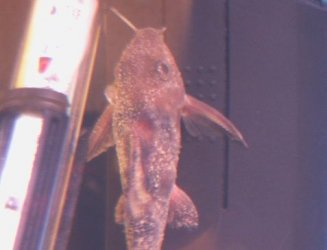MrWhipster
New Member
- Joined
- Apr 11, 2006
- Messages
- 12
- Reaction score
- 0
Request Help
Sorry dont have a full suite of testing kits.
Tank size:36 x 15 x 15
pH:8.0
ammonia:0.6
nitrite: ?
nitrate: < 0.1 mg/l
kH: ?
gH: Dont know but live in hard water area
tank temp:26C
Fish Symptoms (include full description including lesion, color, location, fish behavior):
Only one fish, the Clown Catfish, showing visible signs of some kind of disease. Yellow crusting over whole body. All other fish are ok. except for very occasional rubbing against things in the tank. Other fish have no visible sign of any problem. All fish are feeding quite happily. Clown Catfish did hide under a rock for a few days but has now ventured out into open water and seems content clinging to the internal filter, occassionaly swimmnig around for a few minute or two.
Volume and Frequency of water changes:
29 UK Gallon - weekly approx 1/5 change
Chemical Additives or Media in your tank:
Carbon filter pad in Ehiem Pro II external filter
I also use a Fluval 304 internal filter as a backup
Tank inhabitants:
5 Catfish (1 x Cuckoo , 1 x Royal Pleco, Clown Cat?, 2 x not sure)
13 x Malawi Cichlid
Recent additions to your tank (living or decoration):
8 young Malawi Cichlids about 4 weeks ago. All surviving with no casualties yet.
Ocean Rock about 4 weeks ago
Exposure to chemicals:
None to my knowledge
Digital photo (include if possible):

Sorry dont have a full suite of testing kits.
Tank size:36 x 15 x 15
pH:8.0
ammonia:0.6
nitrite: ?
nitrate: < 0.1 mg/l
kH: ?
gH: Dont know but live in hard water area
tank temp:26C
Fish Symptoms (include full description including lesion, color, location, fish behavior):
Only one fish, the Clown Catfish, showing visible signs of some kind of disease. Yellow crusting over whole body. All other fish are ok. except for very occasional rubbing against things in the tank. Other fish have no visible sign of any problem. All fish are feeding quite happily. Clown Catfish did hide under a rock for a few days but has now ventured out into open water and seems content clinging to the internal filter, occassionaly swimmnig around for a few minute or two.
Volume and Frequency of water changes:
29 UK Gallon - weekly approx 1/5 change
Chemical Additives or Media in your tank:
Carbon filter pad in Ehiem Pro II external filter
I also use a Fluval 304 internal filter as a backup
Tank inhabitants:
5 Catfish (1 x Cuckoo , 1 x Royal Pleco, Clown Cat?, 2 x not sure)
13 x Malawi Cichlid
Recent additions to your tank (living or decoration):
8 young Malawi Cichlids about 4 weeks ago. All surviving with no casualties yet.
Ocean Rock about 4 weeks ago
Exposure to chemicals:
None to my knowledge
Digital photo (include if possible):


